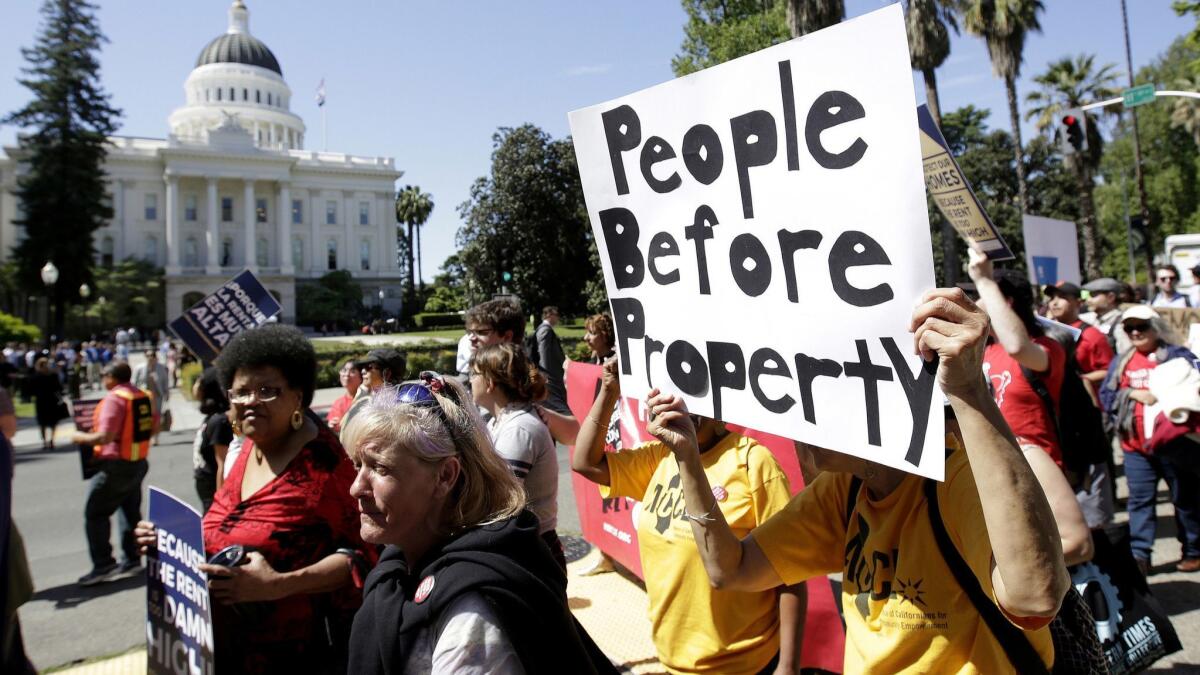Rents on controlled apartments in Los Angeles can now rise 4%. Blame inflation

As of this week, landlords of Los Angeles rent-controlled buildings can raise rent by 4%, the first time in a decade the annual cap isn’t 3%.
The larger increase reflects higher inflation levels and comes as rising rents have been blamed for crimping household budgets and driving people into homelessness. Across Los Angeles and Orange counties, nearly a third of tenants paid more than half their income on housing in 2017, according to Harvard University’s Joint Center for Housing Studies.
“It’s another economic wallop,” said Larry Gross, executive director for the Coalition for Economic Survival. “Most renters in this area are already paying unaffordable rents.”
Rent increases for residents in the city’s roughly 624,000 rent-controlled units are tied to changes in the local consumer price index — a measure of inflation the city uses to “safeguard tenants” while allowing landlords to make “just and reasonable returns.”
Base increases can be as high as 8% and as low as 3%. But with low inflation levels in the wake of the Great Recession, they were kept at the floor for a decade. Last year, inflation accelerated. So as of July 1, landlords can raise rent by 4%.
Not everyone will be hit with such an increase immediately. Some landlords don’t raise rents every year. And rent can only be increased once every 12 months. A landlord who raised rent in May by the then-allowable 3% would have to wait until May 2020 to give a 4% increase.
If gas or electricity is included in the rent, landlords can raise it an additional 1% for each, meaning some tenants could see a 6% increase this fiscal year.
Under California law, all municipalities are bound by rules on what buildings can be rent-controlled. Controls generally can be placed only on older buildings and for existing tenants. When a unit becomes vacant, a landlord can set the rent as high as someone is willing to pay. When the tenant moves in, that person receives assurance their rent can rise only a certain amount each year.
Cities have flexibility on how to set allowable increases. Los Angeles, for example, takes the average change in the CPI for a recent 12-month period, then rounds to the nearest whole number to get the annual cap for the fiscal year, which can be no lower than 3%.
Santa Monica and West Hollywood — two other cities with long-standing rent control ordinances — do it differently. They set increases at 75% of the inflation rate, and if inflation is low enough it’s possible for the city to mandate that landlords not raise rent at all for the year. Current annual increases in Santa Monica stand at 2.9%. Starting in September, the rate will be reduced to 2%.
A number of local municipalities, including Inglewood, Culver City and unincorporated L.A. County, have taken steps to control what landlords charge and how they can remove tenants. Some landlords — often after purchasing a building — have hit tenants with increases of more than 50%, or even 100%, or handed out evictions to renovate units for people who can afford higher rents.
In the state Legislature, a bill seeks to cap annual increases at 7% a year plus inflation, while exempting newer buildings.
Gross said Los Angeles needs to do more to protect tenants. During years in which they could raise rents by 3% while inflation ran below 2%, landlords were able to more than cover their costs, he said. He called for modeling the city’s rent-control ordinance after the more restrictive versions in Santa Monica and West Hollywood.
Several recent studies have found rising rents in high-cost areas leads to increased homelessness, tipping already at-risk people into the streets. In Los Angeles County’s recent homeless count, which showed a 12% rise in homelessness, more than half of those who said they experienced homelessness for the first time cited “economic hardship” as a leading factor. A year earlier, 42% of first-time homeless individuals said “employment/financial” was a cause, while 6.6% cited eviction.
“Often people who are homeless are struggling with several other challenges,” said Jeff Tucker, an economist with Zillow. The recent count, for instance, showed 29% of all people without a home had a “serious mental illness” or reported a “substance abuse disorder.”
“But in a market with more abundant affordable housing, they could have been housed,” Tucker said.
A spokesman for Los Angeles City Councilman Mike Bonin, who has submitted several recent housing proposals, said Bonin would support a rent freeze to stop landlords in rent-control buildings from raising rent.
“Families in Los Angeles are clinging to their housing, stretching every dollar, sacrificing meals, health, and education to keep a roof over their heads,” Bonin said in a statement. “Every rent increase brings families closer to homelessness.”
Economists tend to say the main reason landlords can demand top dollar is because too few homes have been built relative to population and job growth in recent decades. The real estate industry, along with many economists, argues that while rent control laws may help some individual tenants, the rules put upward pressure on rents across the overall market by reducing supply as landlords decide to exit the business and renters who otherwise would want to move stay put.
Daniel Yukelson, executive director of the Apartment Assn. of Greater Los Angeles, said though some people have trouble paying rent, politicians unfairly blame landlords for a complicated homeless problem that, he said, is driven by other forces. He cited a shift from manufacturing to low-wage jobs, as well as mental illness and addiction, which he believes is undercounted in L.A.’s annual survey.
“These are societal problems that entire communities need to solve — people that own apartments cannot solve these issues,” he said.
Already, he said, CPI — a gauge of all consumer prices — doesn’t accurately reflect what it takes to run an apartment building. A variety of costs — including trash, labor for repairs and insurance — have risen sharply in recent years, and even a 4% increase wouldn’t cover the lost profit.
“I have had to cut back on gardening and have deferred painting my building,” Yukelson said of his four-unit L.A. rental property. “Those are the choices we as owners must live with under price controls and excessive regulations.”
Yukelson said he is now selling his L.A. building to escape those regulations and if the city tightened its ordinance, more owners would follow suit rather than grapple with even less ability to respond to rising costs. “You are going to lose a lot of landlords,” he said.
But given the scale of the affordability crisis, Tracy Jeanne Rosenthal, a co-founder of the L.A. Tenants Union, said the city should focus on tenants, rather than profits for business.
Staff writer Doug Smith contributed to this report.
Twitter: @khouriandrew
More to Read
Inside the business of entertainment
The Wide Shot brings you news, analysis and insights on everything from streaming wars to production — and what it all means for the future.
You may occasionally receive promotional content from the Los Angeles Times.











